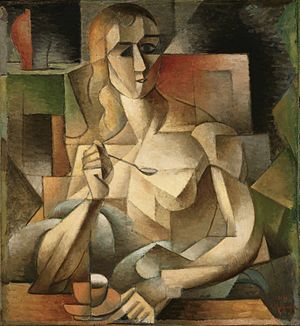Le goûter (Tea Time)
| Le Goûter | |
|---|---|
| English: Tea Time | |
 |
|
| Artist | Jean Metzinger |
| Year | 1911 |
| Medium | Oil on cardboard |
| Dimensions | 75.9 cm × 70.2 cm (29.8 in × 27.6 in) |
| Location | Philadelphia Museum of Art, The Louise and Walter Arensberg Collection, 1950, Philadelphia |
 |
|
|
|
Le Goûter, also known as Tea Time (Tea-Time), and Femme à la Cuillère (Woman with a teaspoon) is an oil painting created in 1911 by the French artist and theorist Jean Metzinger (1883–1956). It was exhibited in Paris at the Salon d'Automne of 1911, and the Salon de la Section d'Or, 1912.
The painting was first reproduced (illustrated) in Chroniques Médico-Artistique, Le Sabotage Anatomique au Salon d'Automne (1911). The following year it was reproduced in Du "Cubisme", by Jean Metzinger and Albert Gleizes (1912). In 1913 it was published in The Cubist Painters, Aesthetic Meditations (Les Peintres Cubistes) by Guillaume Apollinaire. The painting was subsequently published in Arthur Jerome Eddy's Cubists and Post-impressionism, 1914, titled The Taster.
André Salmon dubbed this painting "La Joconde du Cubisme" (La Joconde Cubiste), The Mona Lisa of Cubism (Mona Lisa with a teaspoon).Tea Time "was far more famous than any painting that Picasso and Braque had made up until this time", according to curator Michael Taylor (Philadelphia Museum of Art), "because Picasso and Braque, by not showing at the Salons, have actually removed themselves from the public... For most people, the idea of Cubism was actually associated with an artist like Metzinger, far more than Picasso." (Taylor, 2010)
Le Goûter forms part of the Louise and Walter Arensberg Collection, Philadelphia Museum of Art.
Tea Time is an oil painting on cardboard with dimensions 75.9 x 70.2 cm (29.9 x 27.6 in), signed Metzinger and dated 1911 lower right. The painting represents a barely draped (nude) woman holding a spoon, seated at a table with a cup of tea. In the 'background', the upper left quadrant, stands a vase on a commode, table or shelf. A square or cubic shape, a chair or painting behind the model, espouses the shape of the stretcher. The painting is practically square, like the side of a cube. The woman's head is highly stylized, divided into geometrized facets, planes and curves (the forehead, nose, cheeks, hair). The source of light appears to be off to her right, with some reflected light on the left side of her face. Reflected light, consistently, can be seen on other parts of her body (breast, shoulder, arm). Her breast is composed of a triangle and a sphere. The faceting of the rest of her body, to some extent, coincides with actual muscular and skeletal features (collar bone, ribcage, pectorals, deltoids, neck tissue). Both of here shoulders are coupled with elements of the background, superimposed, gradational and transparent to varying degrees. Unidentified elements are composed of alternating angular structures, The colors employed by Metzinger are subdued, mixed (either on a palette of directly on the surface), with an overall natural allure. The brushwork is reminiscent of Metzinger's Divisionist period (ca. 1903–1907), described by the critic (Louis Vauxcelles) in 1907 as large, mosaic-like 'cubes', used to construct small but highly symbolic compositions.
...
Wikipedia
